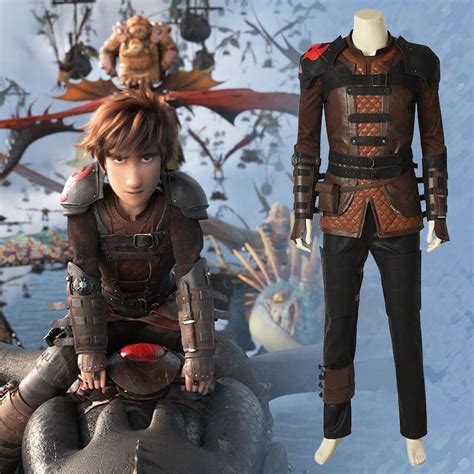My How to Train Your Dragon Hiccup Costume: A Success Story
Creating a truly memorable costume takes dedication, creativity, and a healthy dose of perseverance. My journey to crafting a Hiccup Horrendous Haddock III costume from How to Train Your Dragon wasn't just about sewing and crafting; it was about embodying the character and sharing my passion with others. This is the story of how I brought Hiccup to life, complete with triumphs, challenges, and lessons learned along the way.
Why Hiccup?
My fascination with Hiccup stems from his relatability. He's not your typical hero; he's a skinny, inventive underdog who proves that bravery isn't about size or strength, but about courage and compassion. His journey of forging a friendship with Toothless resonated deeply with me, and I wanted to capture that essence in my costume. More than just a visual representation, I aimed for a true embodiment of the character.
The Planning Phase: More Than Just a Costume
Before I even touched a needle, extensive planning was crucial. I scoured the internet for reference images, focusing on detailed shots from the movies and promotional material. This included:
- Analyzing the clothing: Hiccup's outfit is deceptively complex. It's not just a tunic and pants; the layering, the specific details of the stitching, and the textures all contributed to the overall look.
- Gathering materials: I opted for a blend of fabrics to achieve the right textures. Linen for the tunic offered a realistic feel, while leatherette provided the necessary durability for the arm guards and boots.
- Creating a pattern: While I found some helpful guides online, I had to adapt and create custom patterns to fit my body type accurately. This was a time-consuming but rewarding process.
- Tool acquisition: Beyond basic sewing equipment, I invested in specific tools like a leather punch and stitching groovers to accurately replicate the details of Hiccup's gear.
The Construction: Challenges and Triumphs
The actual construction was a rollercoaster of successes and setbacks.
The Tunic: A Lesson in Patience
Creating Hiccup's tunic was the most challenging part. The intricate stitching and layered design required meticulous attention to detail. I faced several frustrating moments, including seams that unravelled and pattern adjustments, but perseverance paid off. The final result was a tunic that looked remarkably similar to Hiccup's, showcasing the subtle details.
The Leatherwork: Embracing the Details
The leatherette components—arm guards, boot covers, and even the small details like his belt—required specialized techniques. I spent hours practicing stitching and shaping the leatherette to achieve the right look. The subtle distressing and weathering effects I added further enhanced the realism.
The Prosthetic Leg: A Test of Creativity
Creating Hiccup's prosthetic leg was a surprisingly complex undertaking. I used foam, resin, and paint to build a lightweight yet durable piece that looked realistic and blended seamlessly with my costume.
The Finishing Touches: Bringing it All Together
The final touches were crucial in transforming the costume from a collection of individual pieces into a cohesive whole. This included:
- Detailed stitching: I meticulously recreated the distinctive stitching on Hiccup's tunic and other components.
- Accurate coloring: I used multiple shades of brown and beige to achieve the realistic coloring of the tunic and leather.
- Weathering effects: To enhance the realism, I added subtle weathering effects to the tunic and leather components.
The Big Reveal: Sharing the Hiccup Spirit
Wearing the costume for the first time felt incredibly rewarding. It was more than just wearing clothes; it was embodying Hiccup's spirit. The response from others was overwhelmingly positive; many recognized the character instantly, highlighting the accuracy and effort that had gone into the costume. It was a testament to the power of dedication and creativity.
FAQs (People Also Ask)
How long did it take to make the costume?
The entire process, from initial planning to final touches, took approximately three months of dedicated work, averaging several hours per week.
How much did the materials cost?
The cost of materials varied. I found some budget-friendly options for fabric and other components, while some specialty items like the leatherette were more expensive. The total cost was approximately $200, though it could be higher or lower depending on your choices.
What kind of paint did you use for weathering effects?
I used acrylic paints, specifically earthy tones, to create weathering effects. I applied them in thin layers, allowing them to dry naturally to achieve a subtle, realistic effect. Multiple layers helped build the effect gradually.
Where did you find inspiration for the design?
My primary source of inspiration was the How to Train Your Dragon movies themselves. I studied many high-resolution screencaps and promotional art to meticulously capture the details of Hiccup's clothing and accessories.
Would you do it again?
Absolutely! The experience was immensely satisfying, both creatively and personally. While challenging, the process taught me valuable skills, and the final result was incredibly rewarding.
This costume-making journey wasn't merely about crafting a replica; it was about the process, the challenges overcome, and the satisfaction of bringing a beloved character to life. It's a testament to the power of passion and the joy of creation.

